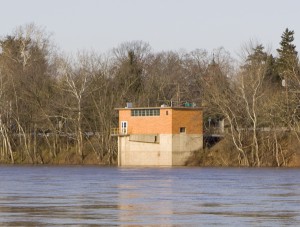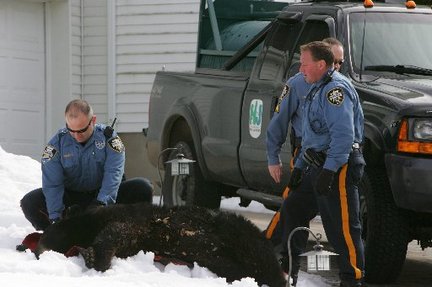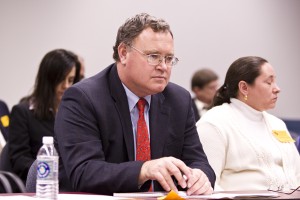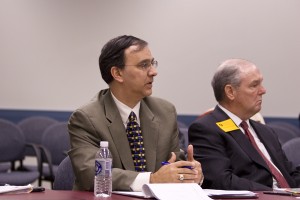This is a story about a DEP clean water standard that is frozen and held hostage by the Christie moratorium at the behest and sole benefit of polluters. Enforcement of this standard is needed to protect drinking water supplies and the ecological health of our rivers, lakes, and streams.
We recently wrote about a drinking water standard for perchlorate – the toxic chemical found in rocket fuel, military explosives, and about 1 in 6 NJ drinking water systems – as the first casualty of Governor Christie’s moratorium.
Before that, we wrote to explain why “in the weeds” fine print of DEP regulations is so important and predicted that DEP regulations would be the target of a stealth industry and Christie campaign to rollback environmental and public health protections under the guise of promoting economic development in response to the economic crisis. Christie is even parroting the chemical industry and NJBIA slogan, “regulatory reform (see: “Corporate America’s Back Door to the Bush White House” for Christie’s playbook)).

Regulatory Czar, Lt. Gov. Guadagno
Today, we warn that a clean water hostage is taken, with Christie’s Regulatory Czar’s gun to its head.
So follow as we break this complex story down. We explain why what Governor Christie’s slogans smear as “Red Tape” and “bureaucracy“, are in reality longstanding, science based, and essential elements to protect public health and the environment.
First of all, to fully understand and respond to the threat, we need to consider the sweeping breadth and systematic nature of the Christie assault.
Christie’s Executive Orders 1-3 did several troubling things, they: 1) targeted and blocked 12 DEP proposed rules; 2) mandated a new cost benefit analysis test for those 12 and all existing rules; 3) established a new federal consistency policy that erects barriers to necessary strong rules and will rollback many; 4) created a “Red Tape Review Group” to make recommendations on those rules; and 5) empowered a Regulatory Czar that can over-ride science and DEP recommendations and veto rules.
The Regulatory Czar can veto DEP rules based on closed door meetings with polluting industries regulated by those same DEP rules. This is a flagrant violation of state and federal administrative and environmental laws, which require transparency, public participation, and accountability. These requirements are in place to achieve what the lawyers call “due process”, restrict “ex parte” intervention by special interests, and establish a formal “administrative record” that is subject to judicial review. Most importantly, laws mandate that regulatory decisions be based on law and science, not politics and/or economics.
As such, the Regulatory Czar contradicts Christie’s repeated promises to increase transparency and promote science over politics at DEP.
In addition to attacking DEP rules, so called DEP technical “Guidance Documents” have been targeted. Guidance documents interpret, implement, and are needed to enforce the rules. Guidance is often referenced but not specifically included in DEP rules. Scores of DEP Guidance documents have come under systematic attack by: 1) a targeted recommendation in the Christie’s DEP Transition Report; 2) A2464, an Assembly bill just released from Committee; and 3) a plan by DEP Acting Commissioner Bob Martin to issue a Administrative Order that would gut any implementation or enforcement of those Guidance Documents by making them voluntary and requiring that DEP could only enforce requirements explicitly included in regulations. Listen to DEP Assistant Commissioner Kropp describe Martin’s upcoming Administrative Order in March 4 testimony to the Assembly Regulatory Oversight Committee by clicking here)
The clean water rule that is held hostage also provides a perfect illustration of why DEP Technical Guidance documents are essential to enforcing environmental laws.
So, follow as I break this down.

Leslie McGeorge, DEP manages water hearing (3/5/10)
On Friday March 5, 2010, DEP held an informal “Stakeholder” meeting to seek comments on how Christie’s EO’s impact the previously proposed but now frozen surface water quality standard for phosphorus.
Phosphorus is a plant nutrient that can lead to excessive growth of algae, a process called eutrophication, which depletes oxygen in the water and kills fish and aquatic life. About 65% of NJ’s rivers and streams and 100% of lakes are eutrophic, fail to meet the phosphorus standard, and are legally “impaired” due to excessive nutrient pollution.
Too much phosphorus, mainly from pollution discharged by hundreds of sewage treatment plants, also is a serious concern for protecting drinking water supplies. Excessive algae requires additional chemical treatment by the water filtration plants. This increases public health risk of drinking water, particularly with respect to birth defects and cancer from “disinfection byproducts“. This is an acute problem in the Passaic River basin, where dozens of sewage treatment plants and industries discharge pollution directly upstream of water supply intakes. Similar but less severe problems exist in the Ramapo, Raritan, Delaware and other NJ rivers that serve as sources of water supply.
Recognizing the public health and environmental significance of reducing phosphorus pollution, in 2002, then DEP Commissioner Brad Campbell directed DEP to enforce the phosphorus standard in the Clean Water Act’s pollution control permit program known as NJPDES. Prior to that, for more than 20 years, sewage treatment plants exploited a loophole in the standard and evaded any limits on phosphorus discharge in their permits. DEP announced:
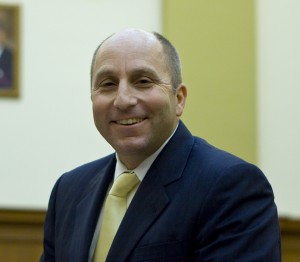
Brad Campbell, DEP Commissioner 2002-2006
On May 24, 2002, Commissioner Bradley M. Campbell announced a new phosphorus initiative at a meeting held with approximately 100 representatives of New Jersey’s publicly owned treatment works. Commissioner Campbell detailed the DEP’s direction to fully implement the numeric Water Quality Criteria (WQC) for total phosphorus. This decision was based on the large number of water bodies listed as impaired due to numerical exceedance of WQC for phosphorus, which is part of the State’s Surface Water Quality Standards (SWQS).
Excessive phosphorus in freshwater streams, lakes and rivers results in algae blooms. These blooms cause depleted oxygen levels, adverse impacts on aquatic populations, and taste and odor problems and additional treatment costs for drinking water suppliers. In 1999, approximately 62 percent of the water bodies statewide exceeded the WQC for phosphorus. The Federal Clean Water Act requires the DEP to impose limits that will prevent/eliminate the violation of SWQS. Therefore, the imposition of Water Quality Based Effluent Limits (WQBELs) in New Jersey Pollutant Discharge Elimination System (NJPDES) discharge to surface water permits is necessary.
Campbell’s order was implemented via a March 2003 guidance document known as the “Technical Manual for Phosphorus Evaluations (see: www.state.nj.us/dep/dwq/techmans/phostcml.pdf . It required a scientific study before sewage treatment plants could invoke the loophole in the water quality standard. As a result, for the first time, hundreds of sewage treatment plants were issued tough new limits on phosphorus pollution.
But the Campbell DEP crackdown caused a political backlash by local sewer authorities who legally appealed and politically challenged their NJPDES permits.
After more than 5 years of this fight, under a new Governor and Commissioner, DEP caved in to the pressure from local sewer authorities.
In April of 2009 (see 41 N.J.R. 1565(a); April 20, 2009), DEP proposed to relax the phosphorus water quality standard, essentially by reinstating the old loophole repaired by the 2003 Guidance and Campbell enforcement initiative. We blew the whistle on this. The Star Ledger reported and on July 1, 2009, wrote a killer editorial that not only nailed the issue, but ultimately forced DEP to withdraw the proposed rollback:
Phosphorus and the DEP: Keeping NJ’s Water Healthy
State environmental officials are considering changes in how phosphorus levels are measured in the state’s rivers and streams, but their proposal is no improvement on the current standard.
Phosphorus is a pollutant that feeds algae in waterways, choking off oxygen and killing fish and other wildlife. Since 2004, the state Department of Environmental Protection has used a numerical standard that measures the presence of the chemical at the point where sewage plants discharge into streams. Anything higher than 0.1 milligrams of phosphorus in the water is a violation , and sewage plant operators must add a chemical treatment to remove the pollutant.
Now the DEP may replace the numerical criterion with a “narrative” standard that would allow varying discharge levels based on site-specific conditions. The change is supported by the Association of Environmental Authorities, which represents 105 water authorities.
Its executive director, Ellen Gulbinsky, said many conditions affect whether a given amount of phosphorous will be dangerous to a waterway, including how much sunlight hits the water and whether it feeds a drinking water supply. “We’re mindful of drinking and discharge water,” she said, but a remedy can be expensive “if done incorrectly, without a goal in mind.” Gulbinsky said it can cost $2 million to build a treatment facility plus higher operation and maintenance costs.
But Bill Wolfe, an environmental activist who was involved in setting the numerical standard when he was at DEP five years ago, said returning to more flexible regulation would allow sewage authorities to conduct endless studies and stall the treatments. It would make it “virtually impossible to enforce a standard,” he said.
There are compelling reasons to keep the current, rigorous standard. Unlike New York, which has large reservoirs, New Jersey depends largely on its rivers for drinking water.
Another strong argument came from those notoriously green folks in the Bush administration.
In January, just before Obama took office, the Environmental Protection Agency informed Florida officials that a numeric standard on phosphorous was necessary for the state to comply with the Clean Water Act. The Sunshine State had relied on the narrative standard.
“Numeric nutrient criteria will provide more precise, predetermined targets . . . and provide greater certainty as to the level of water quality,” the EPA told Florida’s DEP. The federal agency said the narrative approach, “is a difficult, lengthy, and data-intensive undertaking” and causes clean-up delays that would be avoided with a numeric standard.
NJ DEP would do well to review Florida’s experience, and heed the EPA’s advice. It’s the best way to protect both drinking water and the eco-system.
That April 2009 proposal to gut the standard was withdrawn.
Caught with their pants down trying to rollback a key protection by that Star Ledger editorial, DEP was forced to restore the standard in the December 2009 rule proposal now frozen by the Christie moratorium. Under the guise of a “misunderstanding”, clarifying the core of that December rule proposal, DEP said:
Comments received on the April 20, 2009 proposal expressed concern that the Department would not implement a numeric criterion for a waterbody until it determined that the narrative criterion was not met. More specifically, commenters were concerned that the proposal could be interpreted to mean that the applicable numeric criterion would only be applied when it was found that a waterbody did not comply with the narrative criterion. Accordingly, they were concerned that where information or an assessment method was not available to evaluate compliance with the narrative criterion, the applicable numeric criterion would not be imposed. To eliminate this concern and clarify the Department’s intention in such situations, the Department is re-proposing phosphorus numeric criteria for both streams and lakes to indicate that the applicable numeric criterion applies until the Department determines that the phosphorus concentration in the waterbody does not cause undesirable conditions described in the narrative criterion for nutrients.
So now the same political pressure is being brought to bear by local sewer authorities. They have successfully used political pressure to exploit the loophole in the phosphorus standard for 25 years. They successfully pressured DEP to relax enforcement of the standard in discharge permits.
Now they are seeking relief via the Christie Moratorium. Their objective is the same denial and foot-dragging they have been allowed to get away with for the last 25 years: dodge phosphorus limits in their pollution discharge permits.
Polluters are relying the economic cost benefit analysis required by Christie’s EO #2.
Oblivious to the mandates of the federal Clean Water Act, and with no methodology specified or even key terms defined, the Christie Executive Order #2 broadly mandates “cost benefit analysis”. But the federal Clean Water Act strictly limits when state’s may consider economic costs in delegated State clean water programs. The CWA does not allow consideration of costs in setting what are required to be science based water quality standards to protect the fishable and swimmable objectives of the Act (i.e. protect, maintain, & restore the physical, chemical, and biological integrity of the nation’s waters). Regardless of these federal requirements, following EO #2, the DEPÂ crudely solicited comments on:
a. What is the effect of the proposal on New Jersey’s economy?
b. Do the burdens on business and workers outweigh the intended benefits?
But federal CWA policy to oversee State water quality standards programs severely limits when State’s may allowably take into consideration and sets strict safeguards. Federal regulations include specific economic factors and state in detail how State’s may consider them. For example, states may consider costs in 3 places: anti-degradation policy, use designations, and variances:
In order to remove a designated use or obtain a variance, the State or discharger must demonstrate that attaining the designated use would result in substantial and widespread economic and social impacts. Likewise, if a degradation in high-quality water is proposed, it must be shown that lower water quality is necessary to accommodate important social and economic development.
It is simply illegal for DEP to consider the economic factors specified above and the cost benefit analysis of Executive Order #2 in setting the phosphorus standard.
Limits on phosphorus pollution from sewage treatment plants are badly needed NOW to protect public water supplies and the health of NJ’s rivers and streams.
Twenty Five years of delay is unacceptable.
What is going on here is an outrage and must be stopped.


